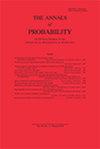通过连接的自回避多边形数量的上限
IF 2.5
1区 数学
Q1 STATISTICS & PROBABILITY
引用次数: 8
摘要
当d≥2d≥2且n∈Nn∈n为偶数时,令pn=pn(d), pn=pn(d)表示ZdZd中长度为Nn的自回避多边形的个数。多边形基数呈指数增长,增长率limn∈2Np1/nn∈(0,∞)limn∈2Npn1/n∈(0,∞)称为连接常数,用μμ表示。马德拉斯(J。Stat. Phys. 78(1995) 681-699]证明了在维数d=2d=2中,pnμ−n≤Cn−1/2。本文建立了当d=2d=2时,对于满密度的偶nn集,pnμ−n≤n−3/2+o(1)。我们还考虑了自回避行走的一种变体,并论证了当d≥3d≥3时,在这种归一化多边形基数的变体模型中,对应的全密度集中存在n−2+d−1+o(1)n−2+d−1+o(1)的上界。本文章由计算机程序翻译,如有差异,请以英文原文为准。
An upper bound on the number of self-avoiding polygons via joining
For d≥2d≥2 and n∈Nn∈N even, let pn=pn(d)pn=pn(d) denote the number of length nn self-avoiding polygons in ZdZd up to translation. The polygon cardinality grows exponentially, and the growth rate limn∈2Np1/nn∈(0,∞)limn∈2Npn1/n∈(0,∞) is called the connective constant and denoted by μμ. Madras [J. Stat. Phys. 78 (1995) 681–699] has shown that pnμ−n≤Cn−1/2pnμ−n≤Cn−1/2 in dimension d=2d=2. Here, we establish that pnμ−n≤n−3/2+o(1)pnμ−n≤n−3/2+o(1) for a set of even nn of full density when d=2d=2. We also consider a certain variant of self-avoiding walk and argue that, when d≥3d≥3, an upper bound of n−2+d−1+o(1)n−2+d−1+o(1) holds on a full density set for the counterpart in this variant model of this normalized polygon cardinality.
求助全文
通过发布文献求助,成功后即可免费获取论文全文。
去求助
来源期刊

Annals of Probability
数学-统计学与概率论
CiteScore
4.60
自引率
8.70%
发文量
61
审稿时长
6-12 weeks
期刊介绍:
The Annals of Probability publishes research papers in modern probability theory, its relations to other areas of mathematics, and its applications in the physical and biological sciences. Emphasis is on importance, interest, and originality – formal novelty and correctness are not sufficient for publication. The Annals will also publish authoritative review papers and surveys of areas in vigorous development.
 求助内容:
求助内容: 应助结果提醒方式:
应助结果提醒方式:


